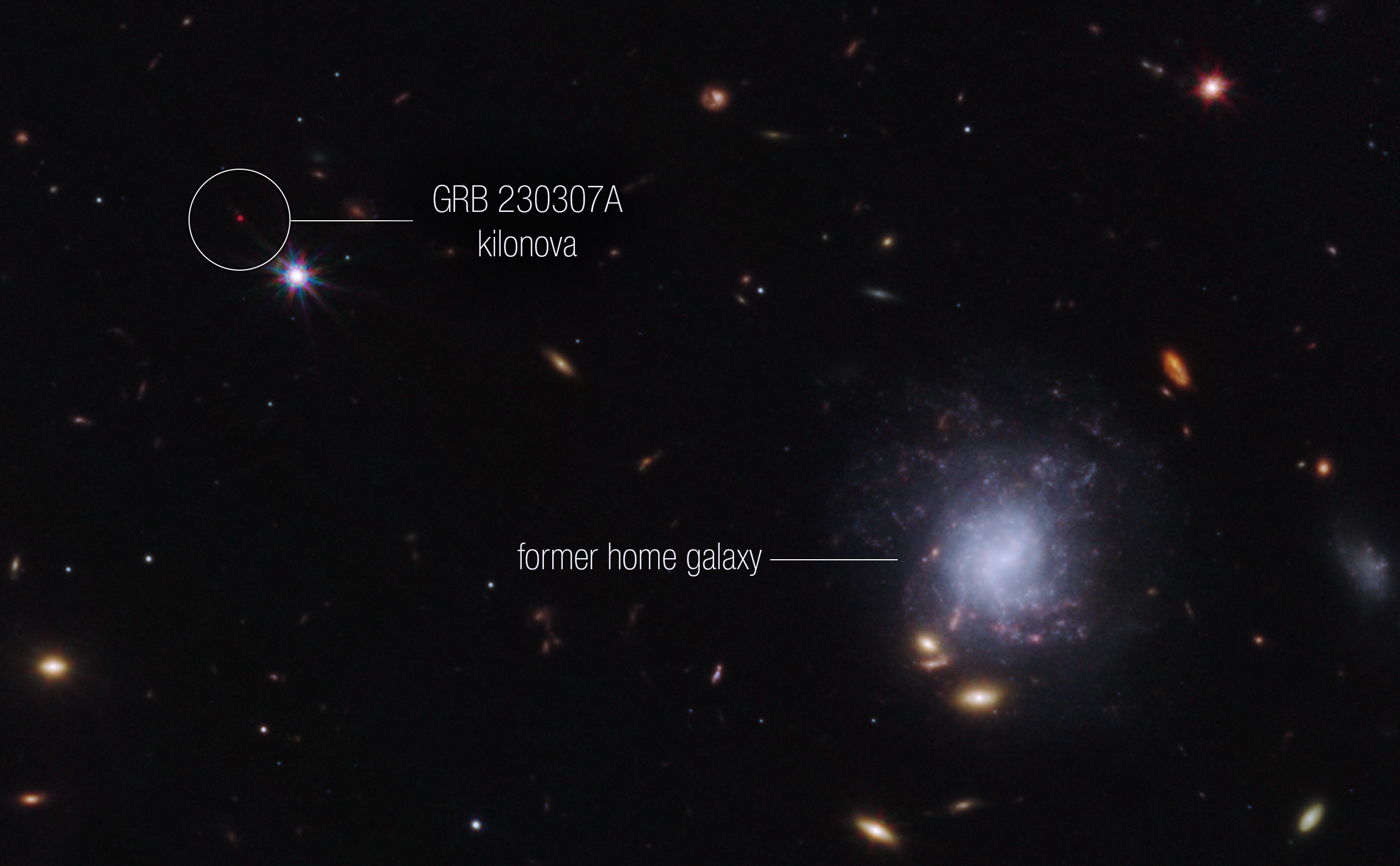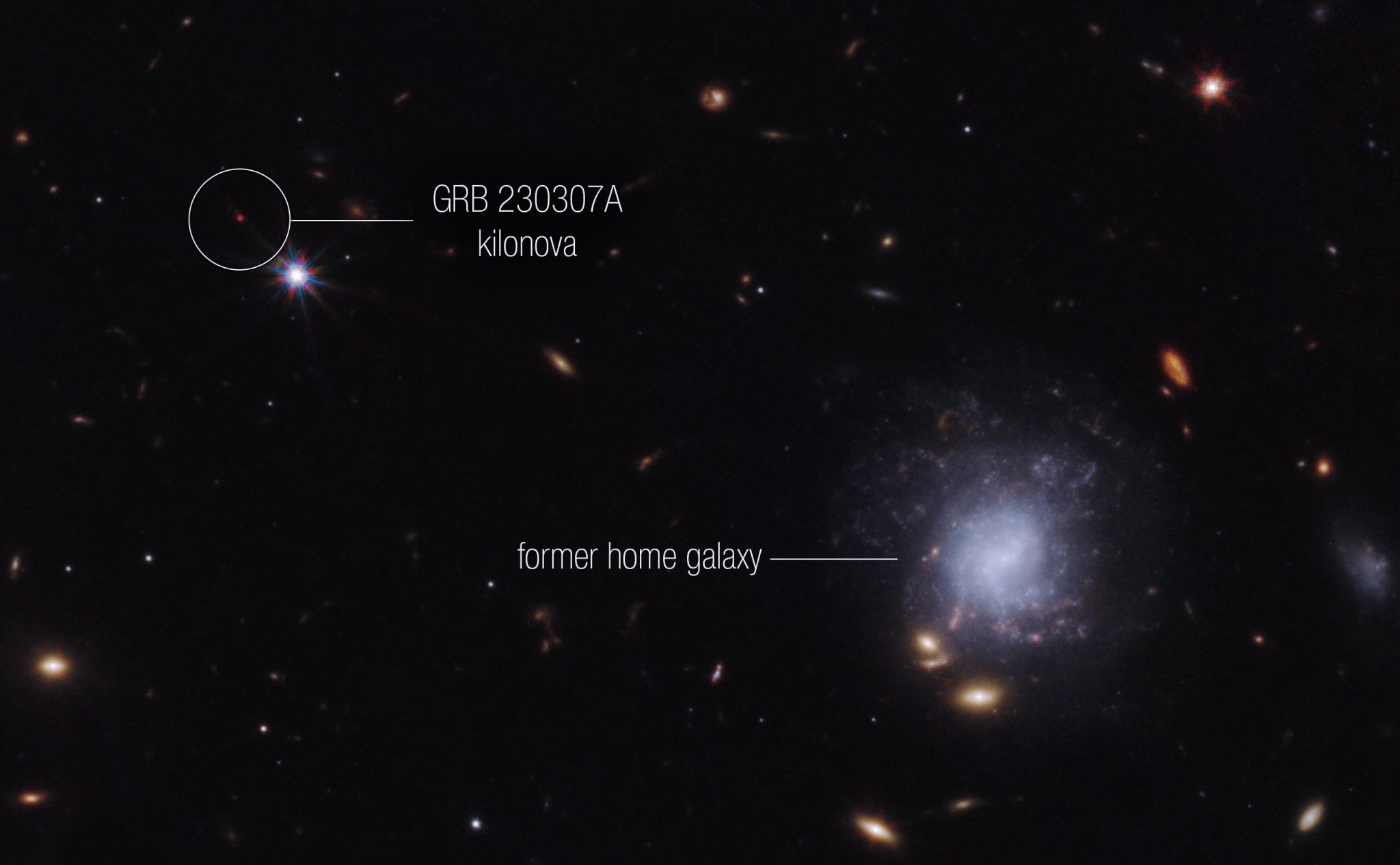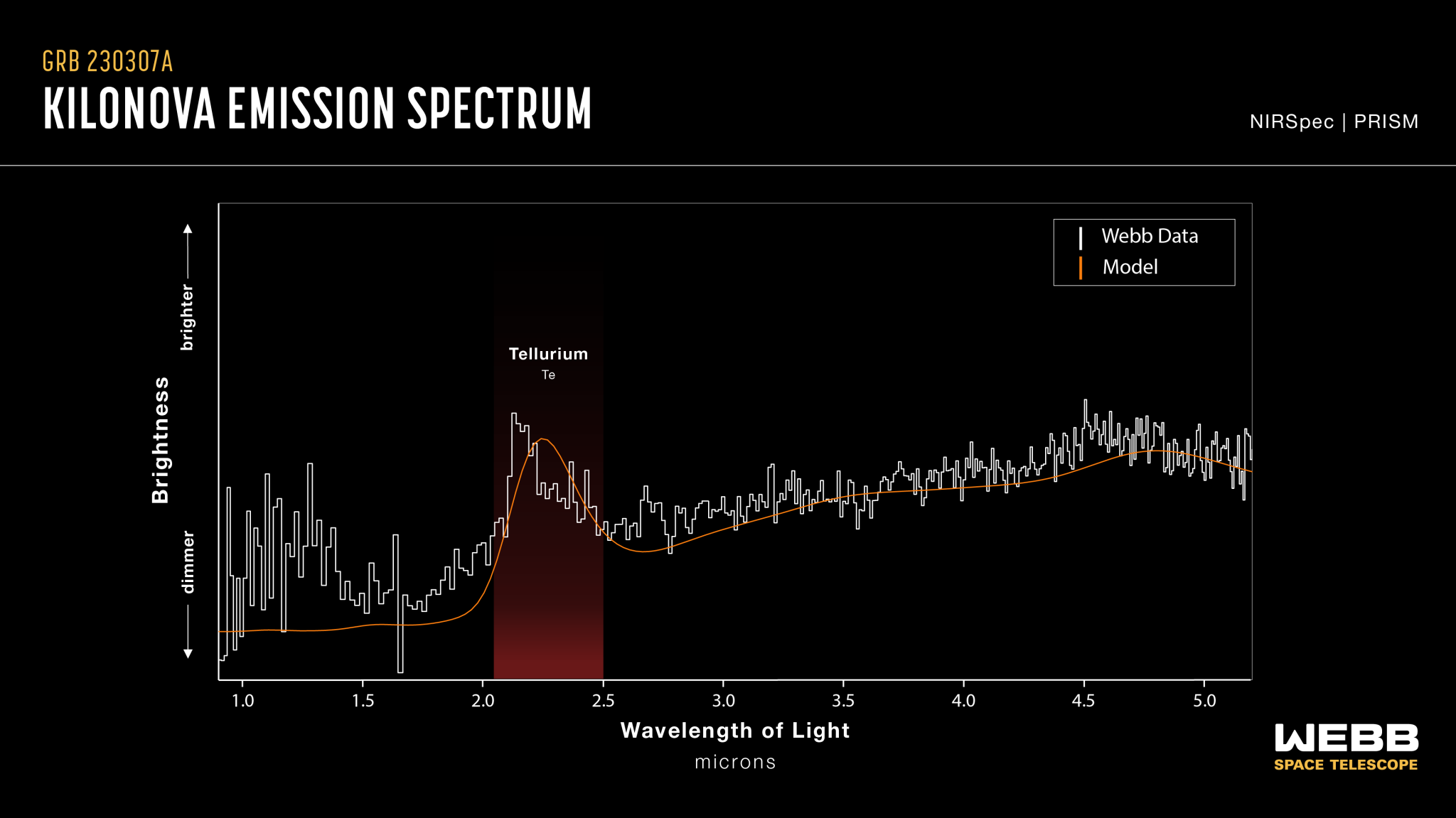NASA’s Webb Makes First Detection of Heavy Element From Star Merger
Webb’s study of the second-brightest gamma-ray burst ever seen reveals tellurium. A team of scientists has used multiple space and ground-based telescopes, including NASA’s James Webb Space Telescope, NASA’s Fermi Gamma-ray Space Telescope, and NASA’s Neil Gehrels Swift Observatory, to observe an exceptionally bright gamma-ray burst, GRB 230307A, and identify the neutron star merger that […]

Webb’s study of the second-brightest gamma-ray burst ever seen reveals tellurium.
A team of scientists has used multiple space and ground-based telescopes, including NASA’s James Webb Space Telescope, NASA’s Fermi Gamma-ray Space Telescope, and NASA’s Neil Gehrels Swift Observatory, to observe an exceptionally bright gamma-ray burst, GRB 230307A, and identify the neutron star merger that generated an explosion that created the burst. Webb also helped scientists detect the chemical element tellurium in the explosion’s aftermath.
Image: Gamma-Ray Burst 230307A

Other elements near tellurium on the periodic table – like iodine, which is needed for much of life on Earth – are also likely to be present among the kilonova’s ejected material. A kilonova is an explosion produced by a neutron star merging with either a black hole or with another neutron star.
“Just over 150 years since Dmitri Mendeleev wrote down the periodic table of elements, we are now finally in the position to start filling in those last blanks of understanding where everything was made, thanks to Webb,” said Andrew Levan of Radboud University in the Netherlands and the University of Warwick in the UK, lead author of the study.
While neutron star mergers have long been theorized as being the ideal “pressure cookers” to create some of the rarer elements substantially heavier than iron, astronomers have previously encountered a few obstacles in obtaining solid evidence.
Long Gamma-Ray Burst
Kilonovae are extremely rare, making it difficult to observe these events. Short gamma-ray bursts (GRBs), traditionally thought to be those that last less than two seconds, can be byproducts of these infrequent merger episodes. (In contrast, long gamma-ray bursts may last several minutes and are usually associated with the explosive death of a massive star.)
The case of GRB 230307A is particularly remarkable. First detected by Fermi in March, it is the second brightest GRB observed in over 50 years of observations, about 1,000 times brighter than a typical gamma-ray burst that Fermi observes. It also lasted for 200 seconds, placing it firmly in the category of long duration gamma-ray bursts, despite its different origin.
“This burst is way into the long category. It’s not near the border. But it seems to be coming from a merging neutron star,” added Eric Burns, a co-author of the paper and member of the Fermi team at Louisiana State University.
Opportunity: Telescope Collaboration
The collaboration of many telescopes on the ground and in space allowed scientists to piece together a wealth of information about this event as soon as the burst was first detected. It is an example of how satellites and telescopes work together to witness changes in the universe as they unfold.
After the first detection, an intensive series of observations from the ground and from space, including with Swift, swung into action to pinpoint the source on the sky and track how its brightness changed. These observations in the gamma-ray, X-ray, optical, infrared, and radio showed that the optical/infrared counterpart was faint, evolved quickly, and became very red – the hallmarks of a kilonova.
“This type of explosion is very rapid, with the material in the explosion also expanding swiftly,” said Om Sharan Salafia, a co-author of the study at the INAF – Brera Astronomical Observatory in Italy. “As the whole cloud expands, the material cools off quickly and the peak of its light becomes visible in infrared, and becomes redder on timescales of days to weeks.”
Image: Killanova – Webb vs Model

At later times it would have been impossible to study this kilonova from the ground, but these were the perfect conditions for Webb’s NIRCam (Near-Infrared Camera) and NIRSpec (Near-Infrared Spectrograph) instruments to observe this tumultuous environment. The spectrum has broad lines that show the material is ejected at high speeds, but one feature is clear: light emitted by tellurium, an element rarer than platinum on Earth.
The highly sensitive infrared capabilities of Webb helped scientists identify the home address of the two neutron stars that created the kilonova: a spiral galaxy about 120,000 light-years away from the site of the merger.
Prior to their venture, they were once two normal massive stars that formed a binary system in their home spiral galaxy. Since the duo was gravitationally bound, both stars were launched together on two separate occasions: when one among the pair exploded as a supernova and became a neutron star, and when the other star followed suit.
In this case, the neutron stars remained as a binary system despite two explosive jolts and were kicked out of their home galaxy. The pair traveled approximately the equivalent of the Milky Way galaxy’s diameter before merging several hundred million years later.
Scientists expect to find even more kilonovae in the future due to the increasing opportunities to have space and ground-based telescopes work in complementary ways to study changes in the universe. For example, while Webb can peer deeper into space than ever before, the remarkable field of view of NASA’s upcoming Nancy Grace Roman Space Telescope will enable astronomers to scout where and how frequently these explosions occur.
“Webb provides a phenomenal boost and may find even heavier elements,” said Ben Gompertz, a co-author of the study at the University of Birmingham in the UK. “As we get more frequent observations, the models will improve and the spectrum may evolve more in time. Webb has certainly opened the door to do a lot more, and its abilities will be completely transformative for our understanding of the universe.”
These findings have been published in the journal Nature.
The James Webb Space Telescope is the world’s premier space science observatory. Webb is solving mysteries in our solar system, looking beyond to distant worlds around other stars, and probing the mysterious structures and origins of our universe and our place in it. Webb is an international program led by NASA with its partners, ESA (European Space Agency) and the Canadian Space Agency.
Media Contacts
Laura Betz – laura.e.betz@nasa.gov
NASA’s Goddard Space Flight Center, Greenbelt, Md.
Hannah Braun – hbraun@stsci.edu , Christine Pulliam – cpulliam@stsci.edi
Space Telescope Science Institute, Baltimore, Md.
Downloads
Download full resolution images for this article from the Space Telescope Science Institute.
Research results published in the journal Nature.
Related Information
Neutron Stars – https://universe.nasa.gov/stars/types/#otp_neutron_stars
Universe/Stars Basics – https://universe.nasa.gov/stars/basics/
Universe Basics – https://universe.nasa.gov/universe/basics/
More Webb News – https://science.nasa.gov/mission/webb/latestnews/
More Webb Images – https://science.nasa.gov/mission/webb/multimedia/images/
Webb Mission Page – https://science.nasa.gov/mission/webb/
En Español
Related Topics









































